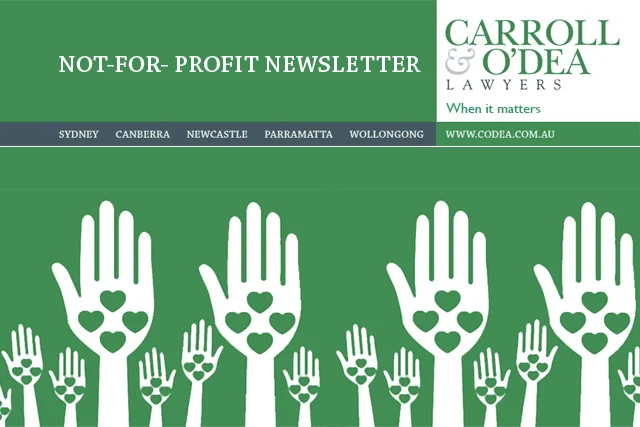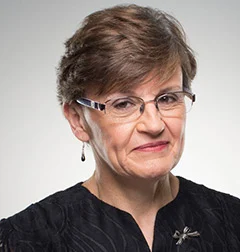
Not-For-Profit Newsletter – September 2013
Published on September 1, 2013 by Josephine Heesh, Patricia Monemvasitis and Peter Punch
In this newsletter we report to you on:
- some recent legislative amendments concerning Australian anti-discrimination law and the impact of those changes on Commonwealth-funded religious aged care providers,
- the introduction from 1 October 2013 of mandatory prescribed forms for village contracts and supporting disclosure documentation under the Retirement Villages Act 1999,
- the recent Australian Federal decision concerning the Hunger Project where it was found that a public benevolent institution does not need to provide direct relief for poverty,
- the celebration of the 30th anniversary of the passing of the revolutionary New South Wales Aboriginal Land Rights Act 1983 during NAIDOC Week, and
- some Good News concerning the charities Give Directly and Connecting Hands and their good works.
The Carroll & O’Dea Workplace Solutions Team report in this newsletter on the anti-bullying amendments to the Fair Work Act 2009 which will commence on 1 January 2014.
Our ACNC Start Up e book has now been posted on our website for your future reference and can be found at (link).
The Carroll & O’Dea not-for-profit law team
RETIREMENT VILLAGES ACT 1999 – NEW CONTRACTS FROM 1 OCTOBER 2013
In New South Wales as from 1 October 2013 operators of villages which are administered under the Act must use a prescribed form of contract when admitting new residents.
The aim of the new contract is to include more information upfront for residents covering:
- whether the resident is acquiring an interest in land, a lease, a licence or some other type of interest in the village;
- all the costs that the resident must pay to enter the village, to remain in the village and to leave the village;
- whether or not the resident will share any ‘capital gain’ in the value of the ‘apartment’ or ‘unit’ realised during the period of occupancy;
- whether a settle in period is available after which the resident could leave without penalty;
- a clear indication of the types of services (for example podiatry, physiotherapy, hairdressing, occupational therapy) and facilities (for example common room, swimming pool, community bus, resident nurse, vital call, library) which are available;
- if any building works or redecorating or alterations are to be done;
- what maintenance is to be provided by the operator compared to what maintenance is to be done by the resident.
In addition to the new form of contract, the following two documents have also been prescribed:
- the general enquiry document which is a summary of village management matters; and
- the disclosure statement to replace the old form disclosure statement and to have a simpler layout.
The design of the new contract allows individual operators to add special clauses in a schedule at the end of the prescribed form. All operators should be reviewing their existing contracts and identifying any particular clauses they use which are not in the prescribed form and are compliant with the Act, so that they can be drafted for the annexure.
A link to NSW Fair Trading provided here takes you to the set of prescribed documents which are available on that website.
PUBLIC BENEVOLENT INSTITUTION
Is it now easier to qualify?
The recent decision of the Hunger Project Australia v Commission of Taxation [2013] FTA 693 has decided that it is not necessary for a charity which is providing benevolent relief to the public to deliver that relief directly.
Formerly, on application to the Australian Taxation Office for public benevolent institution (PBI) status, an entity needed to prove that its work and its activity provided direct relief of poverty, sickness, suffering or distress, misfortune, disability, destitution or helplessness in areas where the public would be moved to empathy.
For example, the types or works which qualified for PBI status would have included organisations which were:
- operating a soup kitchen
- providing meals to homeless people
- operating night patrol services around cities or town for people living rough
- providing community service to disabled people
- assisting children from broken families
- supporting victims of violent crime by offering housing, shelter, clothing and safe places
The work would need to be delivered directly, for example by:
- providing safe houses to persons in need
- providing prepared food, delivering meals, blankets or clothing to persons in need
- conducting activities for disabled people
The Hunger Project decision now means that an entity which is mainly raising money to directly fund such activities can itself have public benevolent institution status.
The Hunger Project entity was raising the money but was closely linked with other entities in the same group who were delivering food to alleviate hunger. It may be that the ATO will require a similar linkage for any new fund raising entities who seek PBI status.
Justice Perram noted that the involvement of the Hunger Project in the relief of hunger was “concrete” We provide some pertinent extracts from his reasoning here.
We await with interest to see if other fund raising limbs of larger charitable organisations attempt to secure their own PBI status.
Here is a link to the ACNC Interpretation statement on how it will interpret the decision.
Commissioner Interpretation Statement CIS 2013/01
THE ANTI-BULLYING AMENDMENTS TO THE FAIR WORK ACT 2009 –
NEW PROTECTIONS FOR WORKERS INCLUDING VOLUNTEERS
Commencing on 1 January 2014, the Fair Work Amendment Act 2013 introduces a new sphere of protection to workers experiencing bullying in the workplace. While the amendments operate within the framework of the Fair Work Act, the insertion of a much broader definition of “worker” than the ordinary meaning of “employee” used in the balance of the Act extends the scope of these provisions to the typical workforce of not-for-profit organisations such as volunteers, trainees and work experience students. The prevalence of bullying complaints by volunteers in the NFP sector was one of the topics discussed at the 15th National Conference on Volunteering, held in Adelaide last week.
The new jurisdiction represents the Government’s response to the 2012 report of the House of Representatives Standing Committee on Education and Employment titled: ‘Workplace Bullying “We just want it to stop”. The report’s principal recommendation was that there be a mechanism for workers to take bullying complaints to a national body for early intervention and resolution. Incidentally, the Report also found that the average cost to employers of resolving a formal claim of bullying is between $17,000 and $24,000.
These important new provisions are summarised below:
- From 1 January 2014, workers (who are, as mentioned, defined very broadly) employed by a constitutionally-covered business, who reasonably believe they have been bullied at work can apply to the Fair Work Commission (FWC) for an order stopping the bullying.
- The definition of “worker” is taken from the Work Health and Safety Act 2011 (Cth & State, excluding Vic and WA) which includes contractors, sub-contractors, outworkers, apprentices, trainees, volunteers, work experience students etc – a significant expansion of the meaning of ‘employee’ in the Fair Work Act.
- ‘bullied at work’ means where an individual or a group “repeatedly behaves unreasonably towards the worker, or a group of workers of which the worker is a member; and that behaviour creates a risk to health and safety”. This is consistent with the definition of bullying in the revised WHS Code of Practice. However, this means that low level workplace conflict that does not create a risk to health and safety will not be actionable.
- to avoid doubt, the Act specifies that “reasonable management action carried out in a reasonable manner” is not bullying. This provision is going to generate a lot of case law because so many bullying allegations arise in the context of performance management and the question of whether such management is reasonable (or unreasonable) is always going to be a matter over which the worker and employer differ.
- the right to complain is provided only to workers of a constitutionally-covered business – that means a trading or financial corporation or a foreign corporation (as well as the Commonwealth, a Commonwealth authority, a company incorporated in a Territory or a business conducted principally in a Commonwealth or Territory place). The right does not extend to workers of a partnership, sole trader or corporation with minimal trading activity – these workers are otherwise protected by the Fair Work Act. There could be an argument that certain Not-for-profit entities – depending on what they do – are not ‘trading’ corporations and so their workers will not have the right to complain.
- the words ‘reasonably believe’ appear to reflect an objective test but the Explanatory Memorandum refers to an employee “feeling victimised or humiliated” which arguably introduces a subjective element to the test.
FWC must commence dealing with applications within 14 days of receipt. That abbreviated time frame means that employers will need to be in a position to respond very promptly to the issues raised in a worker’s application. FWC can deal with a bullying complaint by making virtually any order it considers appropriate except an award of monetary compensation.
Commentators have mixed views about whether this new jurisdiction will be heavily utilised by workers.
FWC anticipates receiving 3,500 applications in the first year and it has been given additional funding of $5.35 million a year to resource the jurisdiction.
Possible Coalition Government amendments
It is possible that the Coalition Government, under PM Abbott, will introduce a ‘filtering’ process whereby bullying complaints will need to be submitted to a regulatory agency (possibly the Fair Work Ombudsman) for vetting before they are allowed through to FWC. However, any Coalition amendments are unlikely to take effect before the anti-bullying laws commence on 1 January 2014.
Pro-active risk management
To minimise their exposure under the new law, employers and affected organisations should commence a thorough review of their anti-bullying and harassment policies, update them where necessary and ensure that their workers (including volunteers, trainees and work experience students) are instructed and trained in the application, operation and effect of the policies. Refresher training at regular intervals is recommended.
Any anti-bullying policy should provide a fair, efficient and confidential complaint mechanism and the consequences of non-compliance with the policy should be made clear to all “workers”, taking into account the very broad definition of that term.
For advice about your current policies, please contact the Carroll & O’Dea Workplace Solutions Group.
RECENT DEVELOPMENTS IN AUSTRALIAN ANTI-DISCRIMINATION LAW
Passed in the last days of the 43rd Parliament, the Sex Discrimination Amendment (Sexual Orientation, Gender Identity and Intersex Status) Act 2013 (‘SDAA’) has now commenced, after being proclaimed as of 1 August 2013.
The SDAA amends the Sex Discrimination Act 1984 (Cth) (‘the Act’) by inserting a range of new protected attributes including sexual orientation, gender identity and intersex status.
New protections
The key changes are most apparent in the following three new distinct heads of discrimination:
- s5A: discrimination on the ground of sexual orientation
- s5B: discrimination of gender identity
- s5C: discrimination on the grounds of intersex status
The Act defines ‘sexual orientation’ as a person’s sexual orientation towards persons belonging to the same sex, a different sex or both. For the purposes of preventing offence or inaccuracy, the definition of sexual orientation does not refer to homosexuality, lesbianism, or bisexuality.
The inclusion of ‘intersex status’ is a significant amendment to the Act, not previously recognised in Australian legislation. As opposed to gender identity, which denotes a person’s identity, appearance or mannerism, the term intersex specifically refers to a person’s biological conditions or characteristics.
A further significant feature of the amendment is its protection of same-sex couples from discrimination on the basis of relationship status. Specifically, the amendment improves upon provisions aimed towards protecting people from discrimination on the basis of ‘marital status’, to provide similar protection to people belonging to same-sex de facto relationships. To that end, the amendment changes several provisions referring to ‘marital status’ with the new construction of ‘marital or relationship status’.
COMMONWEALTH FUNDED AGED-CARE ACCOMMODATIONS
The SDAA also contains a rather significant removal of the traditional exemption covering certain religious institutions running aged-care accommodation.
The exemption under Section 23(3)(c) of the Act, which allowed religious accommodation operators to refuse accommodation and related benefits to persons on the basis of several sex and sexuality protected attributes, is removed for religious bodies providing Commonwealth-funded aged care. The exemption is removed regardless of the level of Commonwealth-funding.
As noted in submissions Castan Centre for Human Rights Law at Monash University and the supplementary explanatory memorandum, the policy decision is aimed at aligning these institutions with the same community standards as already imposed on other Commonwealth funded accommodation providers.
Importantly, the removal of the exemption does not extend to matters of employment by the religious aged-care institution. This is contained in SDAA Section 49B which preserves the exemption in relation to acts or practices connected with the employment of persons to provide aged care. As such, Commonwealth-funded religious aged care providers will still be able to discriminate in making employment decisions based on religious views.
As the supplementary memorandum explains, this limitation is important in recognising and ensuring that “organisations should be able to engage staff who share their values and organisational ethos.“
SIGNIFICANCE
While in office, the Rudd and Gillard Governments endeavoured to address the substantial discrimination that faces Australia’s Lesbian, Gay, Bisexual, Transgender and Intersex (LGBTI) communities.
In 2008, following the Australian Human Rights Commission’s 2007 Same Sex: Same Entitlements Report, the Rudd Government amended 84 pieces of legislation to remove any exclusions to entitlements, such as Medicare and superannuation, that existed for same-sex couples under Federal legislation.
The Sex Discrimination Amendment (Sexual Orientation, Gender Identity and Intersex Status) Act 2013 (Cth) represents a fulfillment of the Gillard Government’s 2010 election commitment to ‘extending discrimination protection’ for Australia’s LGBTI communities.
Beyond its legislative context however, the significance of the reforms are more likely to be realised by the resulting practical changes available for LGBTI people. In conjunction with the provisions of the Australian Human Rights Commission Act 1986 LGBTI people will now have access to the Australian Human Rights Commission as well as the courts when they consider themselves to be discriminated against.
The ability for LGBTI people to have their gender, or intersex status reflected in government records will be a further significant change of the Act. At the street level, this will mean significant change for LGBTI people accessing services such as Medicare and Centrelink.
SPOTLIGHT ON INDIGENOUS AFFAIRS
ABORIGINAL LAND RIGHTS ACT 1983 (NSW)
2013 marks the 30th anniversary of the passing of the New South Wales Aboriginal Land Rights Act 1983 (‘the Act’), recently celebrated as part of NAIDOC week.
The 1983 Act, passed by the Wran Labor Government, was New South Wales’ first piece of land rights legislation. The Act followed a two year consultation period, facilitated by a Legislative Assembly Select Committee chaired by Maurice Keane, which involved 4,000 individuals across the State and received 262 submissions.
The Act significantly acknowledged prior ownership and occupancy, made unused Crown Land available to claim and established mechanisms to facilitate Aboriginal self-determination. While some Aboriginal activists at the time felt that the Act did not go far enough, the High Court’s previous Justice Kirby once characterised the Act as “little short of revolutionary”, considering its pre-Mabo context.
To mark the anniversary the History Council of NSW organised a seminar during NAIDOC week titled “Daring ideas: Is Land Rights Enough?”. A panel of lawyers, lecturers, activists and those involved with the administration of the Act discussed and debated the Act’s current operation. There seemed to be consensus amongst the participants, and members of the audience, that while the Act represented a significant step forward, there is still a way to go to deliver meaningful land rights to Aboriginal Australians.
SPOTLIGHT ON INDIGENOUS AFFAIRS
FEDERAL DEVELOPMENTS
In March this year the Leader of the Opposition, Tony Abbott, announced before the Sydney Institute that if elected a Coalition government would move the ministerial portfolio of Indigenous Affairs into the Department of Prime Minister and Cabinet. He commented that “there will be in effect a Prime Minister for Aboriginal affairs.” The Prime Minister has confirmed in a letter to the Australian population that he will now take these steps.
While Aboriginal leaders have reportedly praised the policy, the previous Federal Minister for Aboriginal Affairs, Jenny Macklin, has labelled it nothing more than “bureaucratic shuffling.”
The Federal Government has only relatively recently been empowered to legislate on Aboriginal Affairs.
In May 1967 90.77% of Australians voted in favour of amending the Constitution to permit Aboriginal Australians to be counted in the census and the Commonwealth to make laws relating to Indigenous Australians. Previously, Aboriginal Affairs had been the purview of State and Territory Parliaments.
While the 1967 Referendum created great hope for change and improvement in the lives of Indigenous Australians, arguably this has not been the reality. Namely, it is reported that today Indigenous Australians remain overrepresented in the criminal justice system, have a significantly lower life expectancy than the non-Indigenous population and, as was discussed in our August newsletter, are still suffering the “devastating effects” of forced child removal as well as dispossession from their land.
THE GOOD NEWS
Story 1
A revolutionary way of running a charity is being trialled by the Not-for-profit ‘Give Directly’ (link).
The experiment aims to go against the existing logic of charity and it is compared to the work done by Heifer International (link).
Give Directly is based on a three-pronged approach of efficiency, transparency and respect and, true to its name, the name the charity aims to give funds directly to those most in need.
At its most basic, the process entails:
- Money is donated through the charity’s webpage.
- A poor household is located in Kenya.
- Donation is transferred electronically to the recipient’s phone.
- Recipient uses funds transfer to pursue his or her own ambitions.
The main aim of the program is to cut out unnecessary red tape and administrative costs and to put money in the hands of those most in need – at the crux of the scheme is the empowerment of the individual.
The approach is not without its critics with some eyebrows raised over a lack of accountability about how money is spent, the sustainability of cash-in-hand charity and the potential for conflict between recipients and non-recipients.
Whilst the scheme is not without its faults the results so far are overwhelmingly positive (see here: link) with the flexibility of the program seen as the key pillar. If anything, this type of approach has forced people to reconsider what works and what does not work in the provision of relief by charities.
THE GOOD NEWS
Story 2
Opening two sister cafes in Melbourne and Phnom Penh, Cambodia’s capital, doesn’t seem like an idea that would be taught in Business 101 but don’t tell that to the not-for-profit entity “Connecting Hands”.
“Connecting Hands” link) is an Australian based charity which aims to give a second shot at life for women and children who have been sold and trafficked into sex slavery in Cambodia.
The idea of opening the sister café’s is in its early stages of development and aims to provide women with the skills required in the hospitality industry (see here: link).
Whilst the Cambodian venture is to provide practical training for recently rehabilitated women, the café in Melbourne is designed to financially support the Cambodian cafe in an accountable and transparent manner.
Connecting Hands is inspired by a true story of a Cambodian sex slave and hopes to see the abolition of modern day trafficking and slavery.
With statistics suggesting that 43% of human trafficking victims are trafficked for commercial sexual exploitation, and 98% of them are women or girls, the need for increased charity work in this area is clearly urgent and overdue.


